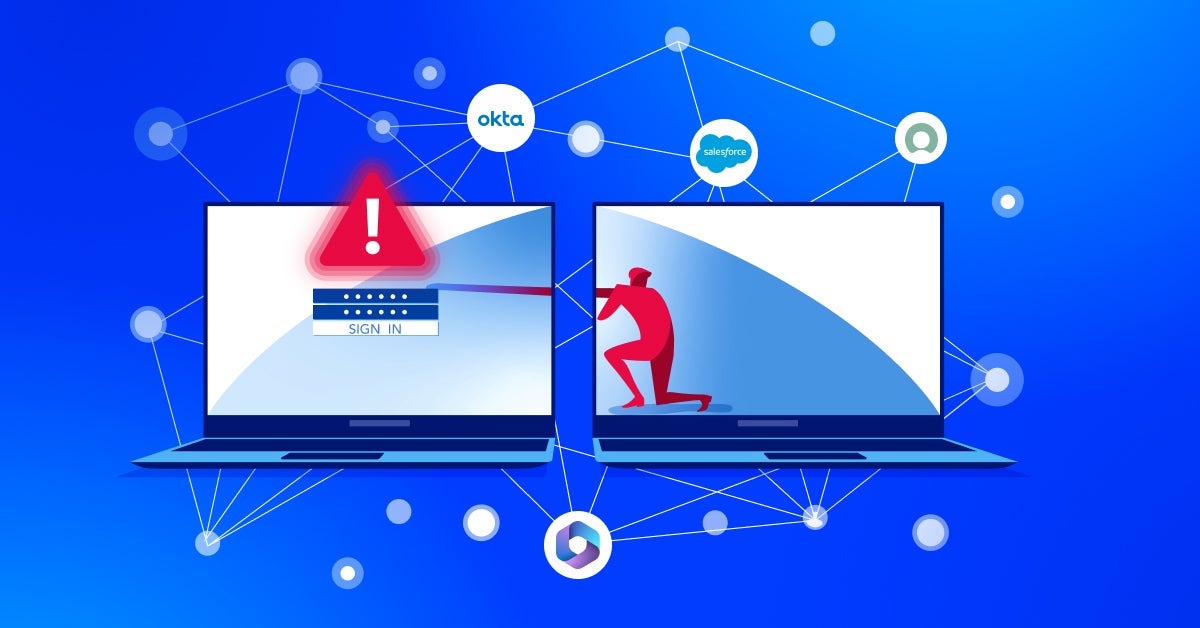Better security with dynamic authentication and authorization decisions
Zero Trust (ZT) is an effective framework that secures today’s distributed organizations by leveraging continuous verification and the principle of “never trust, always verify” — regardless of network boundaries.
A Zero Trust architecture employs robust identity management and other sophisticated security measures to help organizations adapt to the evolving digital environment.
This post dives into one critical element of Zero Trust — enhanced identity intelligence through comprehensive visibility into Software as a Service (SaaS) applications and proactive user threat detection. By integrating these elements into their cybersecurity strategy, organizations can significantly improve their security posture and response capabilities within a Zero Trust framework.
Identity graphs and complete SaaS visibility
Identity graphs play a critical role in comprehensive identity management because they offer a holistic view of a user’s activities and access within an IT ecosystem. The completeness of this identity graph is crucial — identity graphs must encompass not only basic identity data but also detailed insights into SaaS data access, user entitlements, and potentially risky behaviors across SaaS applications.
Organizations must have visibility into these data and insights if they want to secure their cloud environments. By integrating detailed SaaS visibility into identity graphs, organizations can detect subtle anomalies and patterns that may indicate security threats or breaches. For example, if a user is suddenly excluded from MFA requirements via an M365 conditional access policy change, that could signal a compromised user account or an insider threat.
Comprehensive visibility also enables more effective management of third-party risks and helps organizations ensure compliance with regulatory requirements by providing clear insights into who accesses what data and when. Without such visibility, organizations face significant security gaps that can potentially lead to undetected data breaches and compliance issues.
Enhanced SaaS visibility not only closes these security gaps but also strengthens the overall security infrastructure by ensuring that all user activities and access privileges are monitored and managed under the stringent controls mandated by Zero Trust principles.
Enhancing authentication and authorization decisions
In a Zero Trust implementation, every access request is treated with scrutiny — regardless of the requester’s location or device. This rigorous approach to security requires that authentication and authorization decisions are based on comprehensive and accurate data. Enhanced visibility into SaaS applications plays a crucial role in enabling these informed decisions and provides the granular detail necessary for effective access control and identity verification.
With a complete view of user activities and entitlements within their SaaS platforms, organizations can implement dynamic access controls that are finely tuned to the specific requirements of each access scenario. For example, Zero Trust architectures can draw insights on the specific data with which a user can or does interact, normal usage patterns for that user, and their current security posture to dynamically adjust access rights in real time.
This dynamic approach extends beyond mere access control to also determine how authentication mechanisms are deployed. With comprehensive SaaS visibility, the system can determine when additional authentication steps are needed, based on events such as abnormal behavior patterns or access requests that deviate from a user’s typical behavior. These events might trigger multi-factor reauthentication, session or transport termination, or other security protocols to verify the user’s identity before granting access.
Additionally, improved visibility supports another core principle of Zero Trust — granular policy enforcement. Organizations can tailor their security policies to address specific risks associated with different user roles and behaviors within their SaaS environments. For example, users who can access highly sensitive data can be subjected to stricter controls and continuous monitoring, while those with more limited access might experience fewer barriers.
Integrating detailed SaaS visibility into a Zero Trust architecture not only enhances the security and integrity of authentication and authorization processes, but also ensures that these processes are continuously adapted to the evolving context and risk landscape. This dynamic and informed approach is vital for maintaining robust security in modern digital environments, where adaptive threats require adaptive defenses.
Managing the blast radius of data breaches and compromises
In Zero Trust, understanding and minimizing the blast radius — the extent of damage or disruption caused by a security breach or compromise — is crucial for effective risk management. This is especially true when the security event involves an insider threat or compromises related to identities or devices.
A complete and detailed identity graph, when enriched with comprehensive SaaS visibility, is instrumental in managing the blast radius of such compromises. Identity graphs enable organizations to quickly assess the scope of a compromise by providing clear insights into all the resources to which a compromised identity had access. For example, if an attacker gains access to a user’s credentials, the identity graph can reveal which applications, data, and services were potentially compromised. This information allows the organization to instigate a rapid and targeted response.
Immediate visibility into the access and behavior patterns of a compromised account allows security teams to contain breaches more effectively. Security teams can quickly revoke access, limit permissions, or isolate affected systems and significantly reduce the attack’s potential blast radius. Furthermore, this approach supports the implementation of automated responses, where predefined security protocols are triggered based on specific changes in user behavior or access patterns that were detected through continuous monitoring.
Having a comprehensive view of user activities and entitlements also helps in forensic investigations and threat hunting because organizations have access to a trail of user actions before and after the compromise. With this information, security teams can understand how the breach occurred, which vulnerabilities were exploited, and how to prevent future incidents by strengthening security measures and policies based on learned behaviors.
Ultimately, the ability to manage the blast radius effectively depends on how well an organization can monitor, understand, and control the interactions of its users with SaaS applications. By ensuring that all user activities are logged and analyzed, a Zero Trust architecture can not only respond more effectively to incidents but can also adapt its defenses to evolving threats. With this approach, organizations can maintain a robust and proactive security posture.
Identity as the common language in Zero Trust
In Zero Trust, identity serves as the cornerstone of security and underpins all access decisions and interactions within the digital ecosystem. By establishing identity as the common language across all security domains — from network layers to application environments — organizations can ensure a unified and consistent application of security policies.
This integration of identity information across all components of a Zero Trust architecture enables a seamless flow of security-relevant data and enhances an organization’s ability to detect, respond, and adapt to threats in real time. For instance, when identity data is shared across systems, a threat that is detected in one area can inform security responses across the network to prevent lateral movement of attackers and reduce overall exposure.
This unified approach also helps to simplify the security management process. With identity as a central reference point, security teams can apply changes and policies universally, without needing to manage complex mappings or integrations between disparate systems. This approach improves operational efficiency and ensures that security measures are consistently enforced so that there are fewer gaps for attackers to exploit.
The central role of identity in a Zero Trust architecture also facilitates regulatory compliance and audit processes. By maintaining a comprehensive identity-centric audit trail, organizations can provide clear evidence of due diligence in managing access and protecting sensitive data in accordance with regulatory requirements.
Conclusion
Enhanced identity intelligence through SaaS visibility and user threat detection lays the foundation of a Zero Trust Architecture. By integrating these capabilities, organizations not only strengthen their security measures but also gain deeper insights into potential vulnerabilities and threats. This proactive approach ensures that security systems are not just reactive but dynamically aligned with the ever-evolving landscape of cyber threats.
Additional reading on AppOmni’s Zero Trust Posture Management Capabilities
- Introducing Zero Trust Posture Management (ZTPM): Extending Zero Trust Beyond Network Access
- Elevate SaaS Security With Closed Loop Zero Trust
- End-to-End Zero Trust With Zero Trust Posture Management (ZTPM)

See AppOmni in Action
Learn how you can identify data exposure and risks, detect threats, and map compliance requirements with AppOmni.
Related Resources
-

How to Investigate Suspicious User Activity Across Multiple SaaS Applications
Discover practical strategies security teams can use to investigate suspicious activity across SaaS apps, reduce alert noise, and respond to real threats faster.
-

Low-Code, High Stakes: Why Security Can’t Be an Afterthought for Customers Using Salesforce Industry Clouds
New research reveals critical security flaws in Salesforce industry clouds. Discover the risks and how to protect your organization now.
-

OAuth Tokens: The Danger Behind the Commvault Breach
Discover what went wrong in the Commvault breach: How AppOmni’s powerful SaaS security platform steps in to stop threats before they strike.
 New research drives security enhancements for Salesforce industry clouds
New research drives security enhancements for Salesforce industry clouds